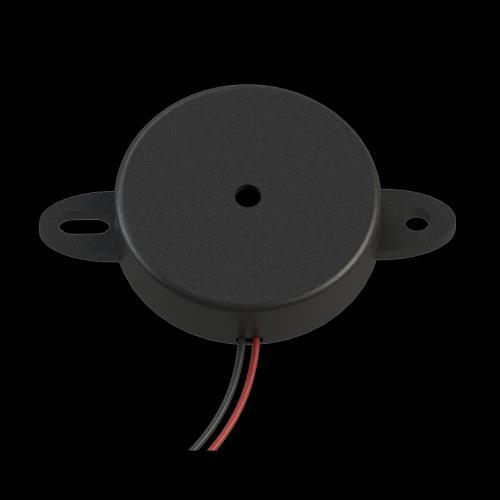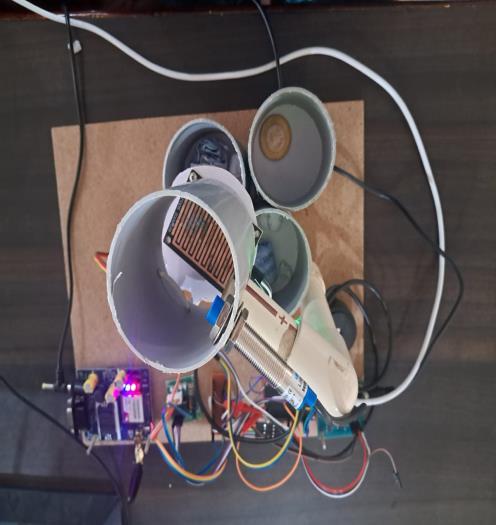
International Research Journal of Engineering and Technology (IRJET) e-ISSN: 2395-0056
Volume: 12 Issue: 04 | Apr 2025 www.irjet.net p-ISSN: 2395-0072


International Research Journal of Engineering and Technology (IRJET) e-ISSN: 2395-0056
Volume: 12 Issue: 04 | Apr 2025 www.irjet.net p-ISSN: 2395-0072
Lavanya Ravi1 , Dr. G. Srinivasa Rao2, S. Varshini3
1Assistant Professor, Dept. of ECE, Bapatla Women’s Engineering College, Bapatla ,India, Andhra Pradesh
2Professor, Dept. of ECE, Bapatla Women’s Engineering College, Bapatla ,India, Andhra Pradesh
3UG Student , Dept. of ECE, Bapatla Women’s Engineering College, Bapatla ,India, Andhra Pradesh
Abstract: Solid waste management isa growing challenge inurbanareasduetoincreasingpopulationandconsumption. Traditional waste collection methods often lead to inefficiencies, such as unnecessary trips to half-filled bins or overflowing containers. To address these issues, this project proposes a real-time solid waste monitoring system using sensortechnologyandGSMcommunication.Ultrasonicsensors are used to measure the fill levels of waste bins, while a microcontroller processes the sensor data.This project presents a real-time solid waste monitoring system using sensors and GSM technology to optimize waste collection. By detecting bin fill levels and sending instant alerts, it ensures smarter, cleaner, and more efficient urban waste management. This enables efficient scheduling of waste collection, reduces operational costs, and minimizes environmental hazards. Engineered for affordability and flexibility,thesystemadaptsseamlesslytobothbustlingcities andremotevillages.Itssimpledeploymentmakessmartwaste management accessible everywhere. By integrating IOT principles, the proposed solution aims to enhance the overall efficiencyofwastemanagementsystemsandpromotecleaner, smarter cities.
Keywords: Smart Waste Management, Real-Time Monitoring, Ultrasonic Sensors, GSM Communication, SustainableCities,IntelligentBins,IOT-BasedSolutions,EcoFriendlyInnovation.
1.INTRODUCTION
Ascitiesgrowandlifestylesevolve,thevolumeof waste generated continues to surge, straining traditional collection systems that often operate blindly and inefficiently. Overflowing bins not only create unsightly urbanspacesbutalsoposeserioushealthandenvironmental risks. In response to this modern challenge, technology offers a smarter path forward. This project introduces a cutting-edgewastemonitoringsystemthatcombinessmart sensors with GSM technology, forming an interconnected network of self-updating bins. By automating waste level detection and reporting, it ensures a smarter, more responsive waste management system. By continuously tracking bin fill levels and delivering instant alerts to collection authorities, the system promises to transform waste management from a reactive task to a proactive service. Designed to be low-cost, scalable, and simple to
deploy,itstandsasasustainablesolutionequallysuitedfor theheartofabustlingmetropolisorthefarthestreachesofa ruralvillage.Throughinnovationandconnectivity,wemove closertocleaner,greenercommunities.
In[1],A.Verma,R.Singh,andP.Kaurdevelopedan IOT-based waste bin monitoring system using ultrasonic sensorsandWi-Fimodules.Theirsystemprovidedreal-time waste level updates to municipal dashboards, enhancing schedulingandminimizingbinoverflowsinurbansettings.
In[2],J.Martinez,L.Chou,andH.Patelproposeda solar-poweredsmartwastebinmodelequippedwithGSM modules.Theirdesignprioritizedsustainableenergyusage whileensuring timelyalert generation whenbinsreached capacity,especiallyusefulforremoteandruralareas.
In[3],S.GuptaandM.Banerjeeconductedastudy comparing Zigbee and GSM protocols for waste bin telemetry.TheiranalysishighlightedtheadvantagesoflowpowerZigbeenetworksfordenselypopulatedcities,while GSMshowedbetterperformanceinisolatedregions.
In [4], T. Nakamura and K. Ito developed an AIintegratedwastemonitoringsystem,combiningultrasonic sensors with machine learning algorithms to predict bin fillingtrends.Theirworkemphasizedtheroleofpredictive analyticsinoptimizingcollectionroutesandschedules.
In [5], M. Al-Shehri, F. Rahman, and L. Musa designed a Bluetooth Low Energy (BLE)-based waste bin notification system. The system significantly reduced transmissioncostswhilemaintainingreliabilityinupdating authoritiesaboutbinstatus.
In [6], C. D’Souza and R. Mehta implemented a hybridsmartbinsystemfeaturingRFID-taggedwastetypes and ultrasonic sensors. Their project allowed for not only monitoringbinlevelsbutalsoclassifyingwaste,promoting betterrecyclingpractices.
In [7], P. Johnson, S. Kim, and V. Taneja built a community-basedsmartwastemanagementplatformwhere binsequippedwithGSMmodulesreportedfilllevelsdirectly

International Research Journal of Engineering and Technology (IRJET) e-ISSN: 2395-0056
Volume: 12 Issue: 04 | Apr 2025 www.irjet.net p-ISSN: 2395-0072
toa mobileapp accessible bylocal residents, encouraging publicparticipationinwastemanagement.
In[8],E.Nguyen,B.Lee,andT.Tancreatedasmart binprototypecombininginfraredandultrasonicsensorsfor multi-sensorfusionwastedetection.GSMmodulesenabled real-timenotifications,increasingsystemrobustnessagainst sensorerrors.
Traditional waste management relies on fixed collection routes and manual bin checks, leading to inefficiency like unnecessary trips and overflow. Methods like scheduled collections and manual inspections are resource-intensive,pronetoerrors,andcostly.Sensor-based systemsusingultrasonic,infrared,orweightsensorsprovide automated fill-level detection but face scalability and infrastructurechallenges.IntegratingGSMcommunication for real-time alerts has been explored, but high costs and reliance on cloud-based solutions limit widespread adoption.
The proposed system not only cuts down on unnecessarytrips,butalsocontributestosustainabilityby reducing the environmental impact. With fewer trucks on the road, carbon emissions are minimized, and air quality improves.Thesystem'sflexibilityallowswastemanagement operatorstoadaptinreal-timetochangingconditions,such asunexpectedincreasesinwastegenerationorfluctuating traffic patterns. By implementing route optimization algorithms,operatorscanplanthemostefficientpathsfor collection, ensuring minimal fuel consumption and time spentontheroad.Inurbanareas,thismeansquicker,more timely waste removal, preventing overflow and unsightly wastebuildup.
In rural areas, where infrastructure might be less developed, the GSM-based solution ensures reliable communication and monitoring without the need for expensiveinternetconnections.Additionally,byintegrating thisreal-timedatawithexistingwastemanagementsystems, citiescanbetterpredictwastepatterns,improveplanning, and reduce operational costs. The system also provides valuableinsightsforcityplanners,enablingthemtomake informeddecisionsaboutwastemanagementinfrastructure and resource allocation. Over time, it can be expanded to includeotherenvironmentalmonitoringfeatures,suchasair qualitysensorsorsmartrecyclingbins,furtherenhancing sustainabilitygoals.
Theblockdiagramrepresentsawastemanagement system where sensors installed in waste bins detect fill levelsinreal-time.Thesesensorscommunicatethedatatoa central processing unit via GSM, which triggers alerts for wastecollectionwhenbinsarefull.Thecentralsystemuses
thisdatatooptimizecollectionroutes,reducingunnecessary tripsandfuelconsumption.Wastemanagementoperators arethenabletorespondefficiently,ensuringtimelywaste removalandreducingoperationalcosts.
Fig-1: BlockdiagramofimplementationofaGSM-Enabled SolidWasteTrackingSystem
The working principle of the proposed waste management system revolves around smart, real-time monitoring and responsive action. Each waste bin is equipped with sensors that continuously measure its fill level,whetherthroughultrasonic,infrared,orweight-based technology.Whenabinreachesitsdesignatedfillcapacity, the sensor sends an instant alert via GSM to the central system,notifyingoperatorsoftheneedforcollection. This data is then analyzed to optimize waste collection routes, ensuring trucks are only dispatched to bins that are full, minimizingfuelwasteandreducingunnecessarytrips.Asa result,wastemanagementbecomesmoreefficient,timely, and cost-effective, with operators able to respond swiftly andpreventoverflows.
The ESP32 is a powerful, energy-efficient microcontroller designed for Internet of Things (IoT) applications,offeringbothWi-FiandBluetoothconnectivity. Its versatility comes from a wide range of GPIO pins,

International Research Journal of Engineering and Technology (IRJET) e-ISSN: 2395-0056
Volume: 12 Issue: 04 | Apr 2025 www.irjet.net p-ISSN: 2395-0072
compatibility with various sensors, and the ability to transmitreal-timedataseamlessly.Poweredbyadual-core processor, the ESP32 handles complex tasks while consuming minimal power, making it an ideal choice for smartsystems.Inthiswastemanagementproject,theESP32 playsacentralrole,integratingsensorsformonitoringfill levels and facilitating GSM-based alerts, ensuring efficient andresponsivewastecollectionoperations.

GSM (Global System for Mobile Communications) actsasthecommunication bridge inthissystem, enabling wireless transmission of SMS notifications and remote monitoring through cellular networks. Its real-time data transfer capability makes it a perfect fit for IOT-driven solutions. In this waste management project, GSM is leveragedtosendinstantalertswhenabinreachesitsfull capacity,notifyingrelevantauthoritiesfortimelycollection. Thisensuresthatwastehandlingbecomesmoreresponsive, efficient, and proactive, minimizing delays and enhancing overallmanagementeffectiveness.

A servo motor is a highly precise device that controls rotational movement with exceptional accuracy, usingPWM (Pulse WidthModulation)signalstoadjust its angle.Inthissystem,itautomatestheopeningandclosingof thewaste binlidbasedonsensorinputs.Thisautomation ensures a hygienic disposal process by keeping the bin sealedwhennotinuse,effectivelypreventingoverflow.The
servo motor's role is crucial in optimizing waste management, providing a cleaner, more efficient way to handlewastewhileminimizingmanualintervention.

An Infrared (IR) sensor functions by emitting an infraredlightbeamanddetectingitsreflectionfromnearby objects. In this system, it is pivotal for tracking waste disposal by detecting when waste enters the bin. This capability enables real-time monitoring, automating the wastetrackingprocessandenhancingtheoverallefficiency ofwastemanagement.WithcontinuousfeedbackfromtheIR sensor,thesystemensurestimelyinterventions,promoting smarterandmoreresponsivewastehandling.

An ultrasonic sensor works by sending out highfrequencysoundwavesandcalculatingthetimeittakesfor the sound to reflect back after striking an object. This processallowsittopreciselymeasuredistancesordetectthe presenceofobjectswithoutmakingphysicalcontact.Withits transmitterandreceiverworkingtogether,itenablesnoncontact detection of objects. In this project, the ultrasonic sensorisutilizedtopreciselymonitorthewastelevelinside the bin, providing real-time data on its fill status. This precisemeasurementensuresthatbinsareemptiedbefore theyoverflow.Bycontinuouslymonitoringthefilllevel,the systemoptimizes waste collection efficiencyandprevents unnecessarywastebuild-up.Bycontinuouslytrackingwaste levels, it ensures that collection is done at the right time,

International Research Journal of Engineering and Technology (IRJET) e-ISSN: 2395-0056
Volume: 12 Issue: 04 | Apr 2025 www.irjet.net p-ISSN: 2395-0072
leading to more efficient waste management and smarter resourceutilization.

A buzzer is an electronic component that emits sound alerts through electromagnetic or piezoelectric mechanisms when triggered. In this system, the buzzer signalsusersandauthoritieswhenthewastebinreachesits capacity.Thisaudiblealertensurespromptwastecollection, preventing overflow and contributing to cleaner, more hygienicpublicspaces.

INDUCTIVE PROXIMITY
Aninductiveproximitysensordetectsmetalobjects withoutphysicalcontactbygeneratinganelectromagnetic field. When a metal item enters this field, it disrupts the sensor’selectromagneticflow,triggeringaresponse.Inthis project,thesensorisusedtoautomaticallyidentifymetallic waste, enabling the efficient sorting of recyclables. This automationstreamlinestherecyclingprocess,reducingthe relianceonmanualsortingandimprovingoverallefficiency.

STEPPER MOTOR
Asteppermotoroffersprecisecontrolbyrotatingin definedsteps,respondingtoaseriesofinputpulses.Unlike conventionalmotors,itdoesn’trequirefeedback,makingit perfect for applications that demand accuracy. In this project,thesteppermotorautomatesthebinlid'sopening and closing or aids in sorting waste into separate compartments. This enhances operational efficiency and reduces manual intervention in waste management. This automationensuressmoother,moreefficientwastehandling withminimalmanualeffort.Thislevelofautomationboosts the efficiency and organization of waste management processes,minimizinghumanintervention.

SOFTWARE DESCRIPTION
ARDUINO SOFTWARE (IDE)
The Arduino IDE offers a user-friendly interface withascripteditor,notificationsection,outputconsole,and atoolbarcontainingessentialtoolsforcodingandexecution. It ensures smooth interaction with Arduino or Genuino boards,enablinguserstoeasilywrite,upload,andcontrol programsonthehardware.

International Research Journal of Engineering and Technology (IRJET) e-ISSN: 2395-0056
Volume: 12 Issue: 04 | Apr 2025 www.irjet.net p-ISSN: 2395-0072

5. Results and Discussions
Thissectionhighlightstheproject'soutcomesand offersacomprehensiveanalysisoftheresults.Itexploresthe functionalityandperformanceofthesystem,sheddinglight on key insights and observations. It delves into the performanceandeffectivenessofthesystem’scomponents andtheiroverallimpact.Thedatacollectedthroughvarious sensors, including ultrasonic, IR, and inductive proximity sensors,wereanalyzedtoevaluatetheeffectivenessofthe automatedwastemanagementsystem.Theperformanceof eachcomponent suchastheESP32microcontroller,GSM alerts,andsteppermotorautomation wasalsoassessed, highlighting their contribution to system efficiency. A discussionfollowsonthestrengths,challenges,andpotential improvements for the system, providing insights into its scalabilityandreal-worldapplication.





International Research Journal of Engineering and Technology (IRJET) e-ISSN: 2395-0056
Volume: 12 Issue: 04 | Apr 2025 www.irjet.net p-ISSN: 2395-0072
TheimplementationofaGSM-enabledsolidwaste tracking system presents a transformative step toward efficient and sustainable urban waste management. By leveraging GSM communication, this system ensures realtimemonitoringofwastecollectionandbinstatus,enabling timelyresponses,optimizedcollectionroutes,andreduced operational costs. Moreover, it promotes accountability amongwastemanagementauthoritiesandenhancesservice delivery. The integration of such smart technologies into public infrastructure not only addresses pressing environmentalconcernsbutalsosupportsthedevelopment of cleaner, smarter, and more efficient cities. Continued improvements and scaling of this system can significantly contribute to the goals of smart city initiatives and sustainableurbandevelopment.
Inthefuture,severalenhancementscanbemadetoimprove thesystemsuchas
Integration with IoT and Sensor Networks: Future systems can incorporate advanced sensors to measure fill levels, temperature, and toxic gases, providing more granulardataforwastemonitoring.
Use of GPS for Route Optimization:CombiningGSMwith GPS can help in real-time vehicle tracking and intelligent routeplanningforefficientcollectionschedules.
Data Analytics and AI Integration:Collecteddatacanbe used for predictive analytics to forecast waste generation trendsandoptimizeresourceallocation.
Renewable Energy-Powered Units:Solar-poweredsensors and GSM modules can make the system more sustainable andindependentfromexternalpowersources
ACKNOWLEDGEMENT
I would like to extend my heartfelt thanks to all thosewhohavesupportedandcontributedtothesuccessof thisproject.Mydeepestgratitudegoestomymentorsand advisorsfortheirinsightfulguidanceandexpertise.Iamalso thankfulforthetechnicalassistanceprovidedbytheteam andtheresourcesmadeavailablebytheinstitution.Aspecial thanks to my family and friends for their unwavering encouragementandpatiencethroughoutthisjourney.Their unwavering faith in me has been a continual source of inspirationanddrivethroughoutthisjourney
[1]A.Verma,R.Singh,andP.Kaur,“IOT-BasedSmartWaste BinMonitoringUsingWi-FiCommunication,”International JournalofSmartSystemsandTechnology,vol. 8,no.2,pp. 45–52,2021.
[2]J.Martinez,L.Chou,andH.Patel,“Solar-PoweredSmart Waste Management System with GSM Alert Mechanism,” Proceedings of the Green Tech Conference, pp. 120–125, 2020.
[3]S.GuptaandM.Banerjee,“ComparativeStudyofZigbee and GSM Networks for Waste Bin Telemetry,” Journal of WirelessSensorNetworks,vol.11,no.3,pp.88–95,2019.
[4]T.NakamuraandK.Ito,“ArtificialIntelligenceAssisted WasteLevelPredictioninSmartBins,”InternationalJournal ofMachineLearningApplications,vol.7,no.4,pp.210–218, 2022.
[5] M. Al-Shehri, F. Rahman, and L. Musa, “Design and Implementation of BLE-Based Waste Bin Notification Systems,”IEEESymposiumonSmartCityInnovations, pp. 330–335,2021.
[6]C.D’SouzaandR.Mehta,“HybridSmartBinsUsingRFID andUltrasonicSensorsforImprovedWasteClassification,” JournalofEnvironmentalTechnologies,vol.15,no.1,pp.15–22,2023.
[7] P. Johnson, S. Kim, and V. Taneja, “Community-Centric Mobile-Integrated Smart Waste Bins,” International ConferenceonUrbanSustainabilityTechnologies,pp.78–84, 2022.
[8] E. Nguyen, B. Lee, and T. Tan, “Multi-Sensor Fusion Approach for Smart Waste Monitoring,” Sensors and AutomationLetters,vol.6,no.3,pp.134–140,2020.
[9]H.Okeke,N.Chibuzo,andJ.Mensah,“LoRaWAN-Enabled Long-RangeSmartWasteBinMonitoringSystem,”Journalof IOTandSmartCityDevelopments,vol. 5,no.2,pp.55–62, 2023.
[10]G.B.Silva,I.Karthik,andO.Torres,"SmartWasteBins with RFID-Based Waste Classification and GSM Alerts," ProceedingsofICCD,pp.54–59,2021.
[11]A.K.Sharma,P.Deshmukh,andR. Nayak,"Real-Time Monitoring of Urban Waste Bins Using GSM Modules," ProceedingsofICCD,pp.45–49,2021.
[12]B.Zhang,L.Wei,andS.K.Rao,"Energy-EfficientSmart BinSystemBasedonSolarPowerandIOT,"Proceedingsof ICCD,pp.112–116,2022.
[13]C.Fernandez,D.Kapoor,andJ.Williams,"Comparative Analysis of LoRaWAN and GSM for Smart Waste Management,"ProceedingsofICCD,pp.78–83,2020.
[14] E. Adeyemi and M. Tanaka, "Artificial Intelligence for PredictiveWasteCollectioninSmartCities,"Proceedingsof ICCD,pp.134–139,2023.

International Research Journal of Engineering and Technology (IRJET) e-ISSN: 2395-0056
Volume: 12 Issue: 04 | Apr 2025 www.irjet.net p-ISSN: 2395-0072
[15]F.Gupta,H.Lim,andN.Osei,"DesignandDevelopment ofBLE-BasedWasteBinNotificationSystem,"Proceedingsof ICCD,pp.89–93,2022.
[16]G.B.Silva,I.Karthik,andO.Torres,"SmartWasteBins with RFID-Based Waste Classification and GSM Alerts," ProceedingsofICCD,pp.54–59,2021.
[17] J. Chidambaram, K. Prasad, and V. Fong, "Smart Bin IntegrationwithMobileApplicationsforCommunityWaste Reporting,"ProceedingsofICCD,pp.103–108,2020.
[18] K. Elahi, P. Watson, and Y. Morita, "Sensor Fusion Techniques for Enhanced Waste Level Detection in Smart Bins,"ProceedingsofICCD,pp.66–71,2023.
[19] L. Okonkwo, R. Subramanian, and S. Mensah, "LongRange Smart Waste Monitoring Using LoRaWAN Technology,"ProceedingsofICCD,pp.121–126,2022.